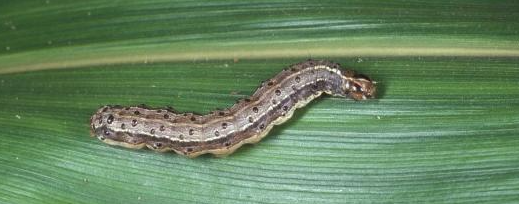
by Sheila Dunning | Nov 4, 2021
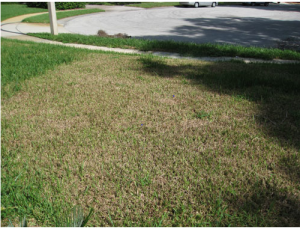
Chewing caterpillar damage on St. Augustinegrass Photo by: Steven Arthurs, UF
Tropical sod webworm larvae are destructive pests of warm season turfgrasses in the southeastern U.S. especially in the fall. Commonly referred to as a worm, they are truly caterpillars, the larvae of a moth. Larval feeding damage reduces turfgrass aesthetics, vigor, photosynthesis and density, which is very evident on finer-bladed grasses such as bermudagrass and zoysiagrass. Feeding damage is possible on all grass types however. Adults, a dull brown colored moth about ¾ inch long, rest in sheltered and shrubby areas during the day and are active at dusk. Females deposit clusters of 10-35 eggs on the upper surface of grass blades. The eggs hatch in 3-4 days and develop from a 1 mm long caterpillar to one over 11 mm long through six instars within 21 to 47 days, depending on temperature. Larval feeding occurs at night, leaving the grass looking ragged, shortened and missing.
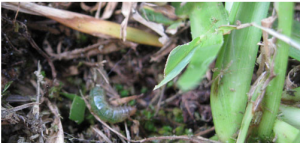
Sod webworm on soil surface
Photo by: Steven Arthurs, UF
Control should be against damaging larvae, not the flying moths. However, insecticidal soap applications to moth harboring areas can reduce re-population frequency. Soil-drenching soap flushes can be used to find the caterpillars, especially in dry and hot grass areas. Bacterial-based insecticides, such as Bt, Bacillus thuringiensis var. kurstaki or Spinosad, will control sod webworm caterpillars without impacting beneficial species as long as they are applied with each flush of grass growth.
Fall armyworms are also active when the weather turns cooler. They feed any time of the day or night, but are most active early in the morning or late in the evening. The 1 ½ inch long gray and white moth lays about 1,000 eggs in multiple masses on any vegetation. Two to 10 days later, the small caterpillar hatches and begins to grow to nearly 2 inches long over a two week period. The fall armyworm is easily recognized by its dark head marked with a distinct pale-colored inverted Y and the long black stripe running along each side of its body. These aggressive feeders “march” rapidly across grassed areas consuming every above-ground plant part. While bacterial-based insecticides will reduce the numbers, control of armyworms usually requires synthetic insecticides.
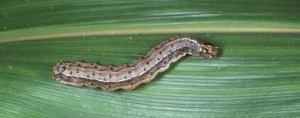
Armyworm
Photo by: Jim Castner, UF
The good news is that grass “worms” can be controlled and the blades will grow back. The damage may be devastating to see, but usually not a permanent problem.
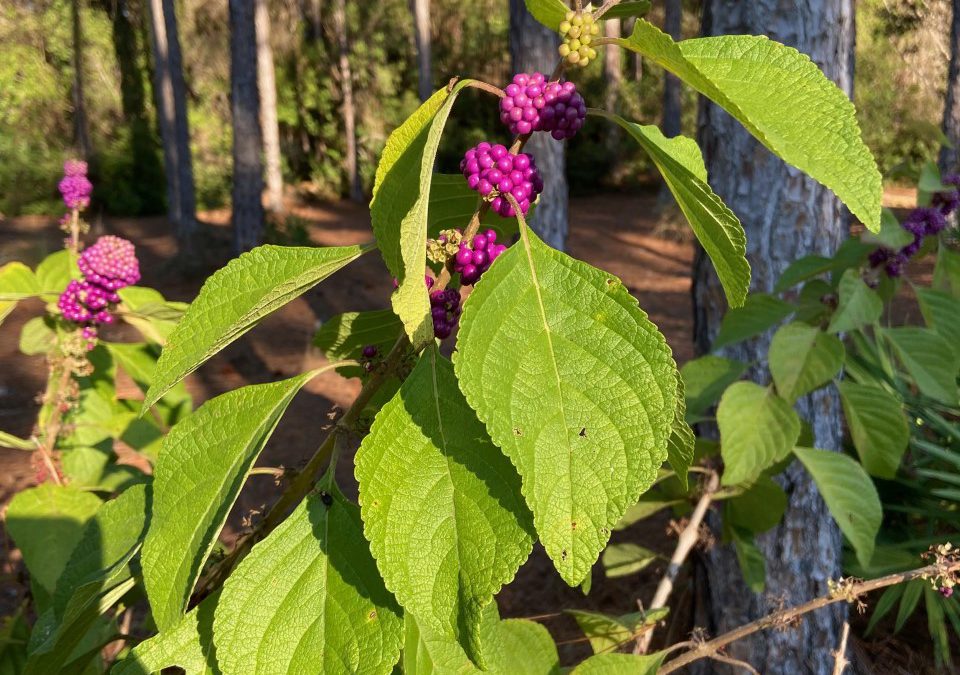
by Stephen Greer | Nov 4, 2021
Many of the native plants in the Northwest Panhandle of Florida are often placed into landscapes as backdrop support plants. Many bring the solid green color to emphasis other colorful plants. What is often missed is the opportunity to see the fall color palate of these plants. Sometimes the easiest thing to do is travel to the nearest nursery to purchase annuals and perennials that come from all over the world and have been time tested to determine their invasiveness outside of planting areas and are determined to be at a minimal risk of colonizing outside of their intended planting area.
Native plants may not be in the thought process and are often overlooked for their exceptional color that can be a focal point in the landscape. Several native plants bring multi-colored leaves or flowers adding fall interest for all to enjoy. Let us take a moment and look at just a few of the plants that can be found in the Florida Panhandle that offer the many colors you may be looking to utilize in your landscape.
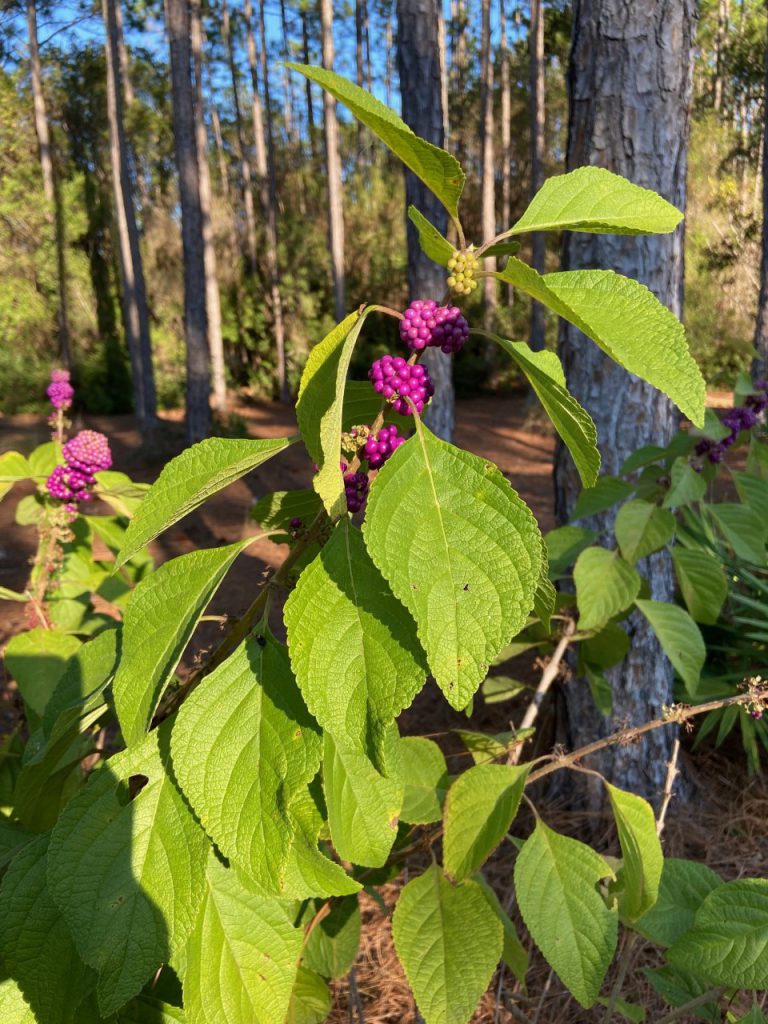
American Beautyberry (Callicarpa americana). Photo courtesy: Stephen Greer, University of Florida/IFAS Extension – Santa Rosa County
American Beautyberry
Beautyberry has two wonderful display times each year. In the late spring to early summer petite light colored lavender flowers open in small clusters along the upright stems of the plant. This flowering can be a brief soft show for a few weeks. The big color show comes in the fall with colorful shiny purple fruit clusters known as drupes. The fruit clusters around the stems of the plant in groups of 20 plus drupes. Often you will see multiple clusters on a given stem spaced approximately 3 to 4 inches apart in the beside the leaf petiole area.
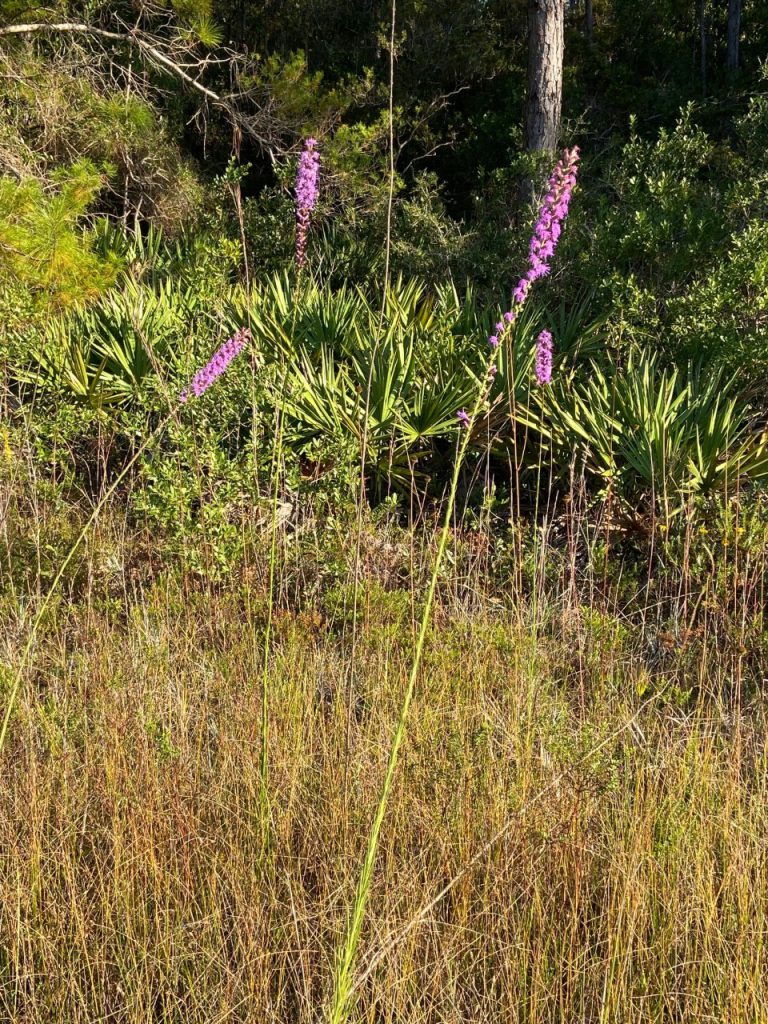
Blazing Star (Liatri spicata). Photo courtesy: Stephen Greer, University of Florida/IFAS Extension – Santa Rosa County
Blazing Star
Blazing star is another fall beauty that creates a great vertical flower floret display of tall spires showing a pleasant medium lavender color. The clustered small flowers provide color in the garden for several weeks. This pollinator plant attacks Monarchs and Swallowtails butterflies plus others adding more enjoyment to the garden. For quality establishment and growth, it needs well drained soil, yet soils that are not high in fertility. Overly fertile soils will over stimulate flower stem growth that will grow too tall and flop over. Blazing star can be divided once it is established and has expanded through underground stem growth creating a wider plant base. In sandy soil sites that have been disturbed through clearing this plant will often establish through seed from adjacent plant settings.
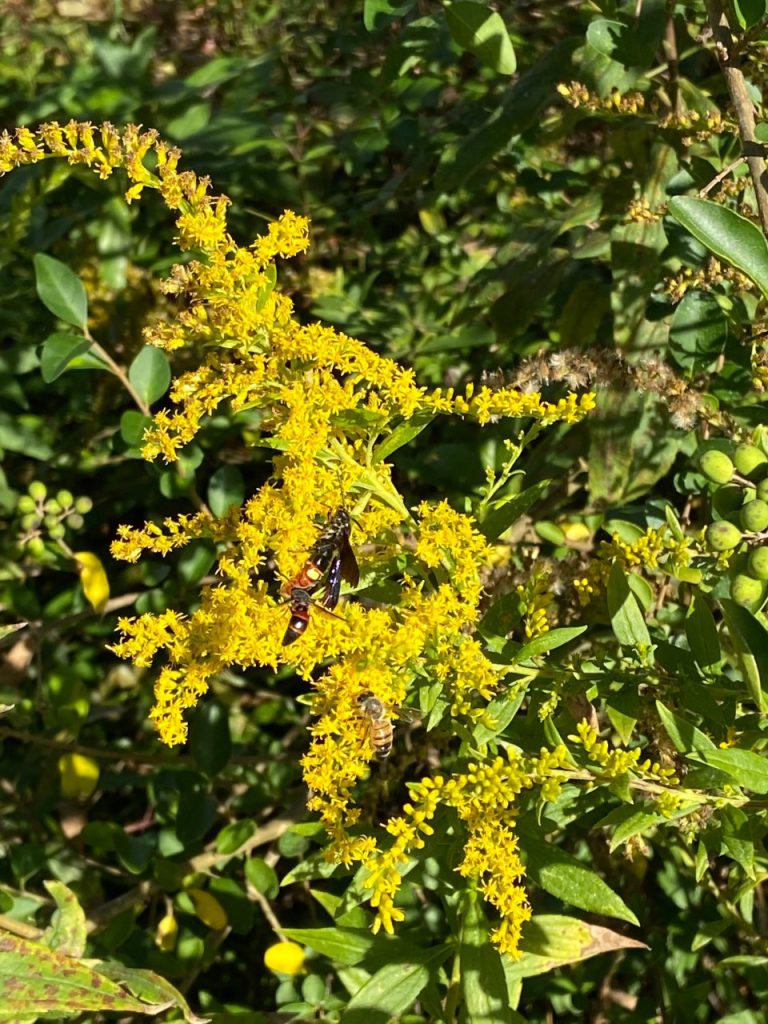
Golden Rod (Solidago spp.). Photo Courtesy Stephen Greer, University of Florida/IFAS Extension – Santa Rosa County
Golden Rod
One of the stronger colors of fall is yellow and the native Golden Rod is a big contributor with its upright stems holding multi-clusters of small bright yellow blooms. This plant serves as a pollinator plant for butterflies, bees and other beneficial insects. Often associated with fall allergies, this plant is not likely the culprit as the pollen is heavy and does not blow on the wind as ragweed will do. Ragweed blooms around the same time and does not have a showy bloom, yet many suffer from allergic reactions to this plant making it the likely problem plant for allergy sufferers. Golden Rod tends to colonize and crowd out other native plants so don’t hesitate to thin out the plant area if it is expanding too quickly.
Growing native plants including fall flowering selections is a fun journey for all to enjoy as the cool hints of fall weather moves in. Do a little research and keep in mind there is an Extension office in every county to assist in addressing your gardening needs.
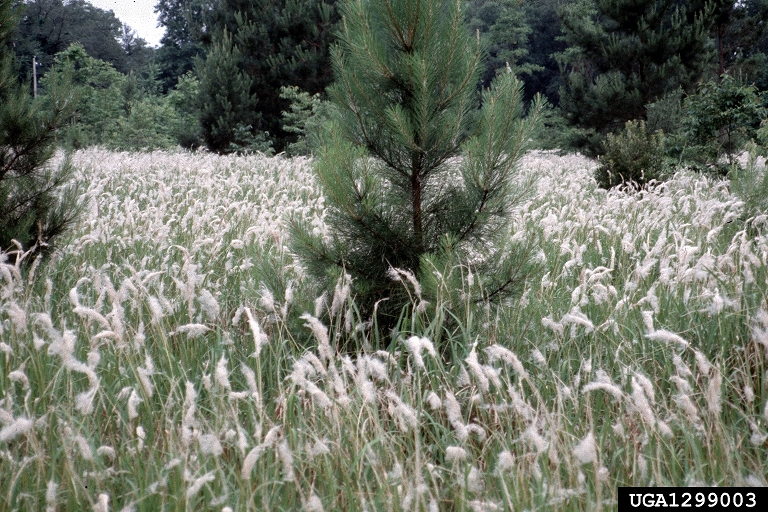
by Matt Lollar | Nov 4, 2021
Invasive species are all around us, from invasive plants like cogongrass to invasive amphibians like Cuban tree frogs to invasive insects like red imported fire ants. These species affect our ecosystems by outcompeting native species for nutrients or food and other precious resources. To help with the management of these noxious organisms, the October 2021 edition of Gardening in the Panhandle LIVE educated the public on invasive species. The highlights from the webinar are listed below.

Cogongrass dominating the landscape. Photo credit: Charles T. Bryson, USDA Agricultural Research Service, Bugwood.org.
Invasive Species Education
For general invasive species terminology please visit. Invasive Species Terminology: Standardizing for Stakeholder Education
Here’s a great resource to help educate the public about invasive plant species. Florida Invasive Plant Education Initiative
The University of Florida has developed a comprehensive list of invasive plant species. Assessment of Non-Native Plants in Florida’s Natural Areas
Invasive Species Control
Cogongrass Control: Cogongrass (Imperata cylindrica) Biology, Ecology, and Management in Florida Grazing Lands
Bamboo Control: Bamboo Control
Chinese Tallow (Popcorn Tree) Control: Natural Area Weeds: Chinese Tallow (Sapium sebiferum L.)
Armadillo Management: Baiting the Nine-Banded Armadillo
Dollarweed Control: Pennywort (Dollarweed) Biology and Management in Turf
Doveweed Control: Biology and Management of Doveweed (Murdannia Nudiflora) in Ornamental Crop Production
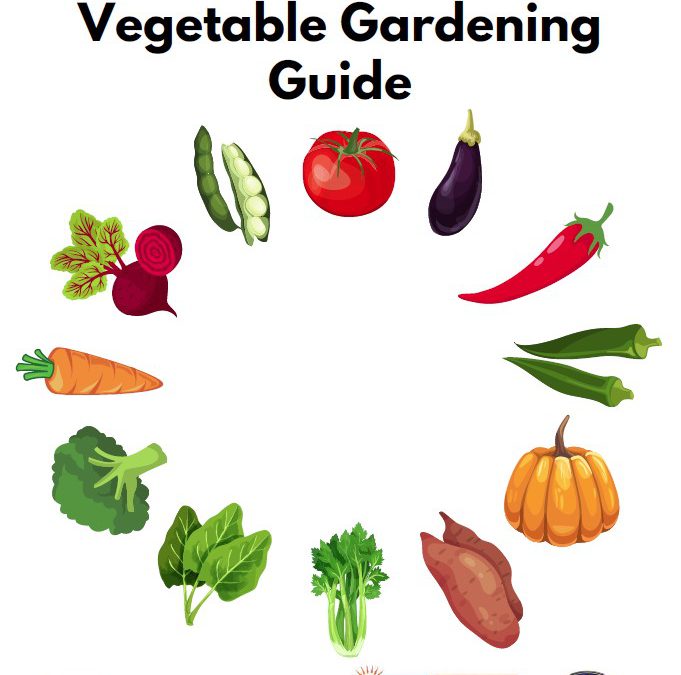
by Molly Jameson | Oct 28, 2021
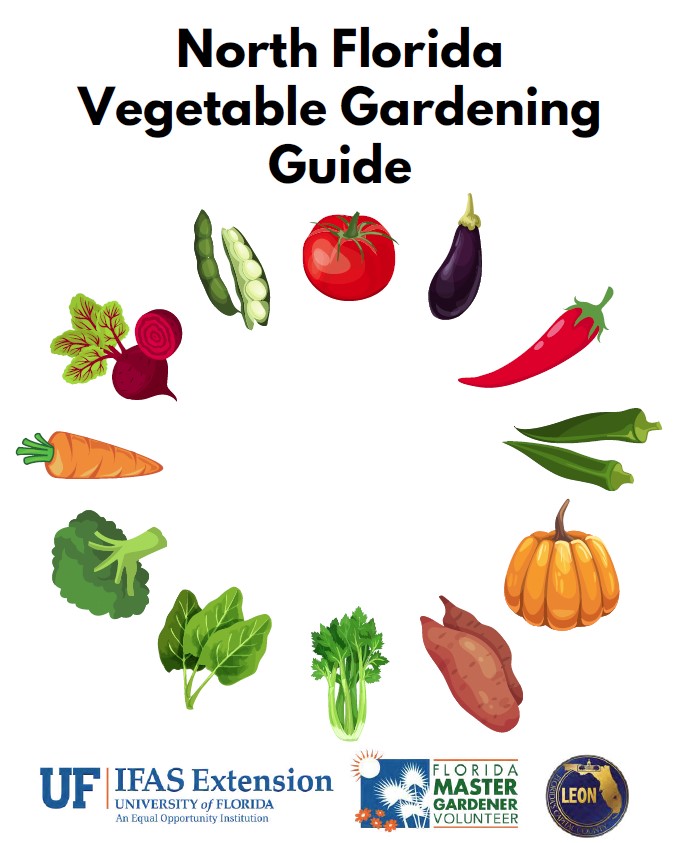
As you garden this fall, check out the North Florida Vegetable Gardening Guide, compiled by UF/IFAS Leon County Extension.
Getting into vegetable gardening, but don’t know where to start?
Even experienced gardeners know there’s always more to learn. To help both beginners and advanced gardeners find answers to their questions, the UF/IFAS Leon County Extension Office put together the North Florida Vegetable Gardening Guide. It incorporates multiple resources, including articles, planting calendars, photos, and UF/IFAS EDIS publications.
The North Florida Vegetable Gardening Guide covers the many aspects of vegetable gardening, including how to get started, site selection, insects and biodiversity in the garden, soil testing, composting, cover crops in the garden, irrigation, and more.
You can click here to view the digital version of the guidebook. We also have physical copies of the guide available at the UF/IFAS Leon County Extension Office (615 Paul Russell Rd., Tallahassee, FL 32301).
Happy fall gardening!
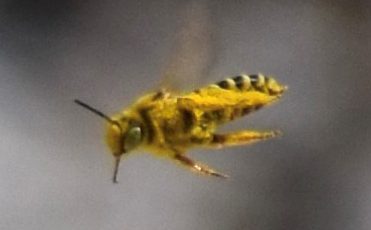
by Carrie Stevenson | Oct 28, 2021
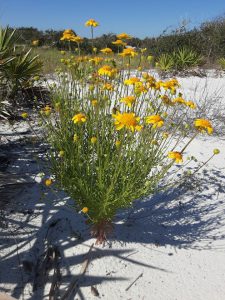
Coastal plain honeycombhead blooms through the summer and early fall on local beaches. Photo credit, Bob Pitts, National Park Service
Over my years of leading people on interpretive trail hikes, I have learned it is particularly important to know the names of the plants that are in bloom. These flowers are eye-catching, and inevitably someone will ask what they are. In fact, one of my favorite wildflower identification books is categorized not by taxonomy, but by bloom color—with a rainbow of tabs down the edge of the book for easy identification.
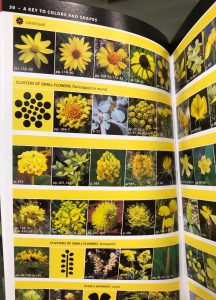
Wildflower identification can be tough, but color-coded guidebooks are really helpful! Photo credit: Carrie Stevenson, UF IFAS Extension
In our coastal dunes right now, several plants are showing off vibrant yellow blooms. Seaside goldenrod, coreopsis, and other asters are common. Rarer, and the subject of today’s post, is the Coastal Plain Honeycombhead (Balduina angustifolia). It has bright yellow flowers, but often gets more notice due to its unusual appearance when not in bloom. The basal leaves are bright green and similar in shape and arrangement to a pine cone or bottlebrush (albeit a tiny one), sticking straight up in the sand. The plants are typically found on the more protected back side of primary dunes or further into secondary dunes, a little more inland from the Gulf.
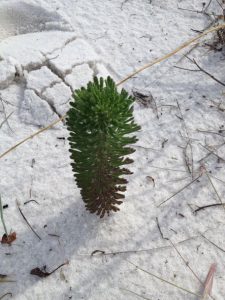
When not in bloom, the plant resembles a green pinecone planted in the sand. Photo credit: Carrie Stevenson, UF IFAS Extension
The plant plays a special role in beach ecology, as a host plant for Gulf fritillary butterflies and the Gulf Coast solitary bee (Hesperapis oraria). The bee is a ground-dwelling pollinator insect that forages only in the barrier islands of Mississippi, Alabama, and Florida. The species is currently the subject of a University of Florida study, as the endemic bee’s sole source of nectar and pollen is the honeycombhead flower. As of publication date, no bee nests have been discovered. Researchers are interested in learning more about the insect’s life cycle and nesting behaviors to better understand and protect its use of local habitats. Based on closely related species, it is believed the Gulf Coast solitary bee builds a multi-chambered nest under the soft sands of the dunes.
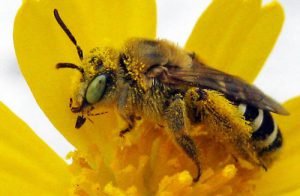
Adult female Hesperapis oraria foraging on coastal plain honeycombhead (Balduina angustifolia). Photograph by John Bente, Florida Department of Environmental Protection, Florida Park Service.
While the honeycombhead plant is found in peninsular Florida and coastal Georgia, the bee has been identified only in a 100 km² area between Horn Island, MS, and St. Andrews Bay, FL. Luckily for the bee, large swaths of this land are preserved as part of Gulf Islands National Seashore and several state parks. Nonetheless, these coastal dune habitats are threatened by hurricanes, sea level rise, and development (outside the park boundaries). Due to its rarity and limited habitat, a petition has been submitted to the Fish and Wildlife Service for protection under the Endangered Species Act.
















